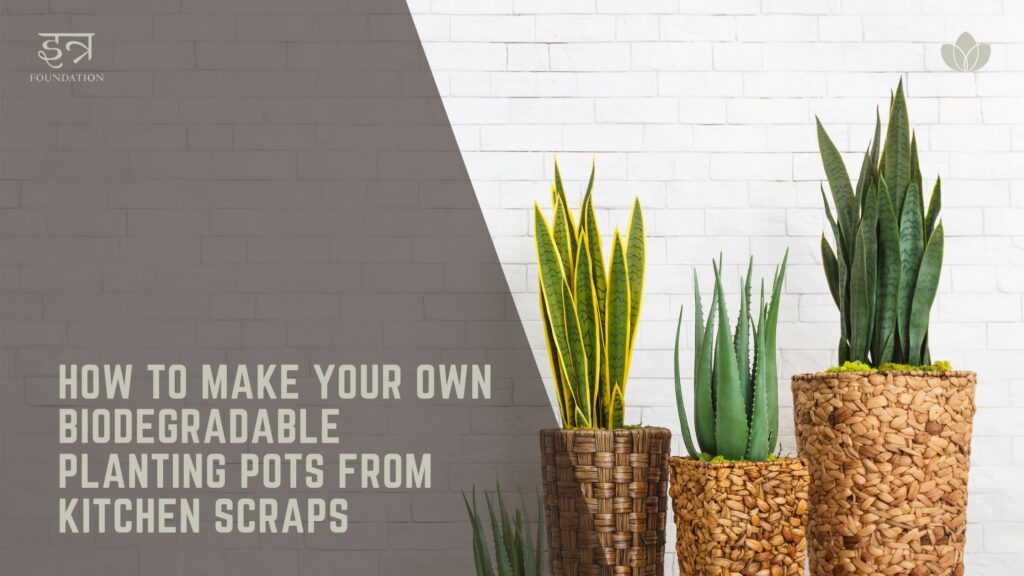Starting your own garden is a rewarding and sustainable way to enjoy fresh produce or beautiful flowers. Instead of using plastic pots that contribute to waste, why not make your own biodegradable planting pots using kitchen scraps? In this blog post, we will guide you through the simple process of creating eco-friendly pots from materials you already have at home. Get ready to reduce waste, nurture your plants, and embark on a greener gardening journey.
Materials Needed:
- Newspaper or Cardboard: Collect old newspapers or cardboard from packaging materials. These will serve as the base material for your biodegradable pots.
- Empty Containers: Look for empty jars, cans, or small bottles that can be used as molds for shaping the pots. Ensure they are clean and have removable bottoms.
- Scissors: You’ll need a pair of scissors to cut the newspaper or cardboard into the required size.
- Water: Keep a small bowl or container of water nearby to moisten the newspaper or cardboard.
- Potting Soil: Prepare potting soil or compost to fill the pots once they are ready for planting.
Step-by-Step Instructions:
- Cut the newspaper or cardboard: Start by cutting the newspaper or cardboard into rectangular pieces. The size will depend on the desired dimensions of your pots. A good starting point is to have pieces that are about 5-6 inches wide and 8-10 inches long.
- Roll the paper or cardboard: Take one piece and tightly roll it around the empty container, leaving about an inch of overlap. This will form the bottom of the pot. Secure the overlapping part with a small piece of tape or by tucking it under the roll.
- Create the sides of the pot: Continue rolling the paper or cardboard, making sure it is tight and snug around the container. When you reach the desired height, fold the excess paper or cardboard inward to form the top rim of the pot.
- Seal the pot: Dip your fingers in water and moisten the top edge of the pot to help it stick together. Gently press down to secure the folded edge.
- Remove the mold: Carefully remove the container from the pot. If the container has a removable bottom, push it up to release the pot. If not, simply slide the pot off the container.
- Repeat the process: Repeat steps 2-5 to create as many biodegradable pots as you need for your gardening endeavors.
- Fill the pots: Place the biodegradable pots in a tray or on a waterproof surface. Fill them with potting soil or compost, leaving enough space for planting seeds or seedlings.
- Plant and care for your plants: Plant your seeds or seedlings in the biodegradable pots according to the specific requirements of each plant. Water and care for them as usual.
- Transplant the pots: Once your plants have grown and are ready for transplanting, simply place the entire biodegradable pot into the ground. The pot will naturally break down, allowing the plant’s roots to expand and grow.
Benefits of Biodegradable Planting Pots:
- Reduce waste: By using kitchen scraps to create biodegradable pots, you are reducing the need for plastic or non-biodegradable materials.
- Eco-friendly: Biodegradable pots break down naturally, minimizing waste and potential harm to the environment.
- Healthier plants: Biodegradable pots allow for better root growth and a smoother transition during transplanting, promoting healthier and stronger plants.
- Cost-effective: Making your own biodegradable pots is an inexpensive alternative to purchasing plastic pots.
Conclusion
Making your own biodegradable planting pots from kitchen scraps is a simple and sustainable way to nurture your garden while minimizing waste. By repurposing newspaper or cardboard and using everyday household items as molds, you can create eco-friendly pots that will naturally break down in the soil, allowing your plants to thrive. Embrace this DIY project and enjoy the benefits of reduced waste, healthier plants, and cost-effective gardening. Get creative, get gardening, and make a positive impact on the environment, one biodegradable pot at a time.





